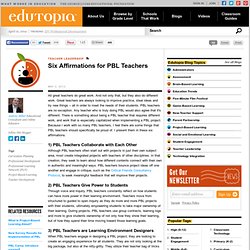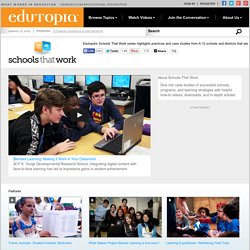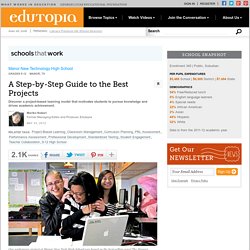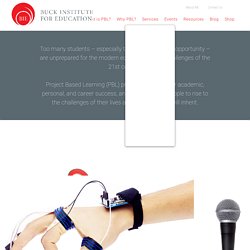

Six Affirmations for PBL Teachers. All great teachers do great work.

And not only that, but they also do different work. Great teachers are always looking to improve practice, steal ideas and try new things -- all in order to meet the needs of their students. PBL teachers are no exception. Any teacher who is truly doing PBL would also agree that it's different. There is something about being a PBL teacher that requires different work, and work that is especially capitalized when implementing a PBL project. 1) PBL Teachers Collaborate with Each Other Although PBL teachers often start out with projects in just their own subject area, most create integrated projects with teachers of other disciplines. 2) PBL Teachers Give Power to Students Through voice and inquiry, PBL teachers constantly reflect on how students can have more power in their learning environment. 3) PBL Teachers are Learning Environment Designers 4) PBL Teachers are Student-Centered PBL teachers know it isn't about them. 6) PBL Teachers Really Plan.
Schools That Work: Search Model Schools, Education Videos, and Teaching Resources. Skip to main content Sign InRegister Facebook Edutopia on Facebook Twitter Edutopia on Twitter Google+ Edutopia on Google+ Pinterest Edutopia on Pinterest WHAT WORKS IN EDUCATION The George Lucas Educational Foundation Edutopia's Schools That Work series highlights practices and case studies from K-12 schools and districts that are improving the way students learn.

Share712 Share Blended Learning: Making it Work in Your Classroom At P. About Schools That Work Dive into case studies of successful schools, programs, and learning strategies with helpful how-to videos, downloads, and in-depth articles. Advertisement Features Travel Journals: Student-Created Textbooks What Makes Project-Based Learning a Success? Learning Expeditions: Rethinking Field Trips Nine Strategies for Reaching All Learners in English Language Arts Resources and Downloads for Differentiated Instruction 10 Takeaway Tips for a College-Bound School Culture Integrate the Arts, Deepen the Learning Preparing Students for Career Success prev next. A Step-by-Step Guide to the Best Projects.
Manor New Technology High School in Manor, Texas, is a 100 percent project-based learning school.

They are part of the New Tech Network of schools and their approach has yielded remarkable results, including a 98 percent graduation rate, with all of their graduates accepted to college. The success of their PBL approach is largely attributable to the fact that their process is designed to stimulate student inquiry.
Additionally, their process can be applied to any project in any subject, which means there is a consistent approach across grades and subjects at Manor. We followed a sophomore world studies class through a three-week project called Controlling Factors, created by teaching partners Mary Mobley (English) and Michael Chambers (world history). They designed a project that capitalized on the wild popularity among their students of the best-selling novel The Hunger Games. Here is a breakdown of key steps, with some examples from Mobley and Chambers's project:
What is PBL? To help teachers do PBL well, we created a comprehensive, research-based model for PBL — a "gold standard" to help teachers, schools, and organizations to measure, calibrate, and improve their practice.

In Gold Standard PBL, projects are focused on student learning goals and include Essential Project Design Elements: